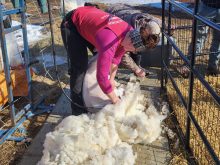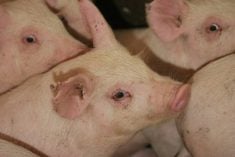Legislation has been introduced in the United States that would restrict the use of antibiotics in the livestock industry but Canada is not likely to follow suit.
A bill sponsored by Republican Louise Slaughter was tabled in the House of Representatives March 17 that would ban the use of animal health products that prevent or control disease. A similar bill sponsored by Democrat Edward Kennedy was re-introduced in the Senate the same week.
“My legislation will limit the use of antibiotics on our livestock to ensure that we are not inadvertently creating antibiotic-resistant diseases that we can’t fight with modern medicine,” said Slaughter, a microbiologist with a master’s degree in public health.
Read Also

Charges laid after cattle theft
Saskatchewan RCMP lay two charges against a man after six cattle went missing.
Similar legislation isn’t proposed at this time in Canada, said Jean Szkotnicki, president of the Canadian Animal Health Institute.
According to estimates by the Union of Concerned Scientists, 23 million kilograms, or nearly 70 percent of all antibiotics sold in the U.S., have been used in the livestock sector in the last two years for purposes other than treating disease.
“The practice of over-using antibiotics in animal feed is certainly contributing to the rise of antibiotic-resistant bacteria,” Slaughter said.
Two million Americans acquire bacterial infections during hospital stays every year and 70 percent of those infections are resistant to the drugs used to treat them. Antibiotic-resistant bacteria costs the American health system an estimated $4 to $5 billion US a year.
U.S. livestock producers say both pieces of legislation are irresponsible and misleading.
“We are committed to maintaining the well-being of our animals and we need access to a wide range of animal health products to keep our pigs healthy and, in turn, produce safe food products,” said Don Butler, president of the U.S. National Pork Producers Council.
“These bills will prevent that and we’ll see more pigs die and higher production costs and that means consumers will pay more for pork.”
Council spokesperson Dave Warner said one study showed a ban similar to what was enacted in Denmark would cost hog producers $4.50 a head.
“That’s a lot of money, particularly since they lost about $22 a head in 2008.”
Warner said the bills, both of which have been previously introduced, may not go anywhere on their own. However, they could be tacked on as amendments to pending food safety or child nutrition legislation, which are much larger bills.
The American livestock industry contends the legislation would also ban antibiotics for preventing or controlling disease.
“You could only use antibiotics to treat disease. You have to wait until your pigs get that disease and then give them the antibiotic,” Warner said.
The result will be more sick animals, and studies have found a greater presence of food safety pathogens in the carcasses of animals that were once sick.
Szkotnicki said the drugs used in the livestock industry have been proven safe for humans and animals. She doesn’t think politics should be trumping science. As well, she said there is no proof the proposed bills would have the desired impact. While resistance pools have declined in livestock in Denmark, antibiotic resistance has increased in humans.
But according to Joanne Carney, director of the American Association for the Advancement of Science, there is proof that antibiotics used in agriculture contribute to rising resistance in humans.
A recent study of seven hog farms in Iowa showed that 70 percent of the 209 nasal swabs obtained from the pigs on those farms contained the methicillin-resistant S. aureus (MRSA) bacteria. As well, 64 percent of the workers on those farms tested positive for genetically similar MSRA, indicating the resistance is transferred between species.
An estimated 18,000 human deaths and 94,000 infections were attributed to MRSA in 2005.
“Due to thousands of animals being confined to a small space, agricultural settings are a reservoir of resistance with a potential to spread dangerous bacteria to the larger community,” Smith said during a recent Capitol Hill briefing on the subject.

















